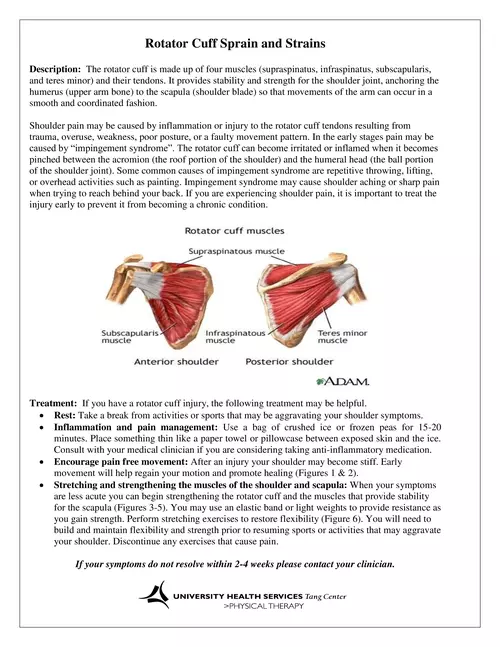
Rotator Cuff Sprain and Strains
ROTATOR CUFF Strengthening Perform the indicated exercises ______ days/week. 60. GENERAL INSTRUCTIONS INTERNAL ROTATION: with the arm at the side.
adsPart of the document
Rotator Cuff Sprain and Strains
Description: The rotator cuff is made up of four muscles (supraspinatus, infraspinatus, subscapularis,
and teres minor) and their tendons. It provides stability and strength for the shoulder joint, anchoring the
humerus (upper arm bone) to the scapula (shoulder blade) so that movements of the arm can occur in a
smooth and coordinated fashion.
Shoulder pain may be caused by inflammation or injury to the rotator cuff tendons resulting from
trauma, overuse, weakness, poor posture, or a faulty movement pattern. In the early stages pain may be
pinched between the acromion (the roof portion of the shoulder) and the humeral head (the ball portion
of the shoulder joint). Some common causes of impingement syndrome are repetitive throwing, lifting,
or overhead activities such as painting. Impingement syndrome may cause shoulder aching or sharp pain
when trying to reach behind your back. If you are experiencing shoulder pain, it is important to treat the
injury early to prevent it from becoming a chronic condition.
Treatment: If you have a rotator cuff injury, the following treatment may be helpful.
Rest: Take a break from activities or sports that may be aggravating your shoulder symptoms.
Inflammation and pain management: Use a bag of crushed ice or frozen peas for 15-20
minutes. Place something thin like a paper towel or pillowcase between exposed skin and the ice.
Consult with your medical clinician if you are considering taking anti-inflammatory medication.
Encourage pain free movement: After an injury your shoulder may become stiff. Early
movement will help regain your motion and promote healing (Figures 1 & 2).
Stretching and strengthening the muscles of the shoulder and scapula: When your symptoms
are less acute you can begin strengthening the rotator cuff and the muscles that provide stability
for the scapula (Figures 3-5). You may use an elastic band or light weights to provide resistance as
you gain strength. Perform stretching exercises to restore flexibility (Figure 6). You will need to
build and maintain flexibility and strength prior to resuming sports or activities that may aggravate
your shoulder. Discontinue any exercises that cause pain.
If your symptoms do not resolve within 2-4 weeks please contact your clinician.
Rev 9/11
Ƒ Pendulum Swings (Fig. 1) Ƒ Flexion Stretch (Fig. 2)
Ƒ Prone Rowing (Fig. 3) Ƒ Prone Horizontal Abduction (Fig. 4)
Ƒ Side lying External Rotation (Fig. 5) Ƒ Posterior Capsule Stretch (Fig. 6)
.
Lean over bending at the hips. Use
tabletop for support. Perform easy
movements with your arm in all directions.
A light weight may be used to provide
gentle traction. Perform movement for 1-2
minutes
Clasp hands or hold onto a
cane or broomstick. Keep
knees bent. Stretch arms
overhead. Repeat 10 times.
Lie on your stomach with your arm
hanging straight down. Bending elbow,
lift hand towards armpit while squeezing
the shoulder blade. A light weight can be
used to provide resistance. Do 2-3 sets of
10 repetitions.
Lie on your stomach with your arm
hanging straight down. Raise arm straight
out to the side so that it is parallel to the
floor and perpendicular to the body. The
palm should face the floor. Do 2-3 sets of
10 repetitions.
Lie on uninvolved side. Place a rolled-up
towel in your armpit. Keep your elbow at
your side while lifting your forearm away
from your abdomen. Let hand down
slowly when returning to start position. A
light weight may be used for resistance.
Do 2-3 sets of 10 repetitions.
Grasp the elbow of the involved arm.
Gradually pull it across the chest to
stretch the back of the shoulder. Keep
shoulder blade depressed to avoid
pinching the front of the shoulder.
Hold 10-30 seconds and repeat three
times.


